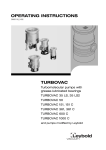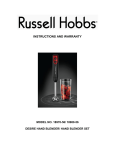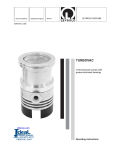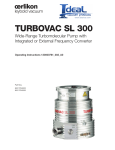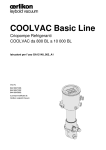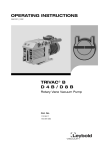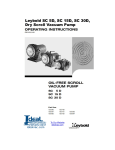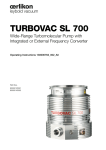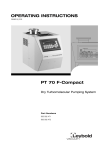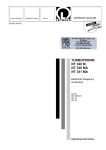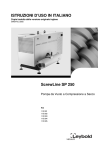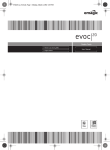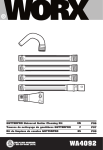Download TURBOVAC 151, 151 C Operating Instructions
Transcript
TURBOVAC Turbomolecular pumps with grease-lubricated bearings TURBOVAC 35 LS, 35 LS2 TURBOVAC 50 TURBOVAC 151, 151 C TURBOVAC 361, 361 C TURBOVAC 600 C TURBOVAC 1000 C and pumps modified by Oerlikon Leybold Vacuum Operating Instructions GA05118_1502 idealvac.com (505)872-0037 idealvac.com Contents Page 2 Important Safety Information 3 1 Description 6 1.1 Design and Operation 6 1.2 Supplied Equipment 6 1.3 Technical Data 7 1.4 Ordering Information 12 1.5 Operating environment and cooling 13 2 Transport and Storing 14 3 Installation 15 3.1 Conforming Utilisation 15 3.2 Ambient Conditions 15 3.3 Connecting the pump to the vacuum chamber 16 3.4 Forevacuum connection 20 3.5 Connecting the cooling 20 3.6 Connecting the purge gas and airing device 22 3.7 Connecting the TURBOTRONIK 23 4 Operation 24 4.1 Media Compatibility / Purge Gases 24 4.2 Start-up 25 4.3 Bakeout 26 4.4 Operation 26 4.5 Switching Off 26 4.6 Venting 27 5 Maintenance 29 5.1 Maintenance Intervals 29 5.2 Oerlikon Leybold Vacuum Service 29 5.3 Cleaning 30 5.4 Removing the pump from the system 30 6 Troubleshooting 31 7 Waste Disposal 33 EC Manufacturer’s Declaration 34 GA05118_1502 - 12/2006 - © Oerlikon Leybold Vacuum Safety Information Important Safety Information Indicates procedures that must be strictly observed to prevent hazards to persons. Warning Indicates procedures that must be strictly observed to prevent damage to, or destruction of the product. Caution The Oerlikon Leybold Vacuum TURBOVAC have been designed for safe and efficient operation when used properly and in accordance with these Operating Instructions. It is the responsibility of the user to carefully read and strictly observe all safety precautions described in this section and throughout the Operating Instructions. The TURBOVAC must only be operated in the proper condition and under the conditions described in the Operating Instructions. It must be operated and maintained by trained personnel only. Consult local, state, and national agencies regarding specific requirements and regulations. Address any further safety, operation and/or maintenance questions to our nearest office. Failure to observe the following precautions could result in serious personal injury! Mechanical hazards Risk of injury! Avoid exposing any part of the human body to the vacuum. Only handle the pump when it is vented. Warning Turbopumps as described in the following operation manual contains a high portion of kinetic energy due to their high rotational speed in combination with the specific rotor mass. In case of a malfunction of the system for example rotor/stator contact or even a rotor crash the rotational energy is released. To avoid the destruction of the equipment and to prevent injuries of the operating staff the leading European manufacturers of vacuum pumps strictly recommend to follow the installation instructions as given in this manual! Never operate the pump (in bench tests, for instance) without its being flanged to the vacuum chamber. The small-flange connector for the high-vacuum flange at the TURBOVAC 50 is not strong enough to keep the pump from rotating if it should suddenly seize. Rotation of the pump can cause leaks in the forevacuum line. Secure the pump additionally to prevent rotation in case it should suddenly seize. GA05118_1502 - 12/2006 - © Oerlikon Leybold Vacuum 3 Safety Information Electrical hazards Warning Risk of injury! Dangerous voltages are present at the mains connections. Before beginning with any maintenance or service work on the pump, disconnect the pump from all power supplies. Operate the pump only with the matching frequency converter and connector line. Voltages of up to 400 V will be present at the connection cable between the frequency converter and the pump; mains voltage will be present at the fan, the flange heater, the valves and their supply leads. Route the conductors and cables so as to protect them from damage. When the connector cable to the TURBOVAC is attached, the outputs of the TURBOTRONIK frequency converter are not free of voltage. Thermal hazards Warning Risk of injury! The pump can become so hot during operation (> 70°C, 158 °F) as to represent a burn hazard. Shield the hot components against contact. Note the symbols on the pump pointing to the hazards, and in the case of a hot pump wear the required protective clothing. Hazards caused by materials and substances Warning The forevacuum line must be tight. Hazardous gases could escape from leaks or the gases being pumped could react with air or humidity. Take the appropriate precautionary measures prior to opening the intake or discharge connection if the pump has previously handled hazardous gases. If necessary, use gloves, a respirator and/or protective clothing and work under an exhaust hood. Risk of explosion! The standard version of the pump is not suited for operation in explosion hazard areas. Contact us before planning to use the pump under such circumstances. Contaminated parts can be detrimental to health and environment. Before beginning with any work , first find out whether any parts are contaminated. Adhere to the relevant regulations and take the necessary precautions when handling contaminated parts. 4 GA05118_1502 - 12/2006 - © Oerlikon Leybold Vacuum Safety Information Failure to observe the following precautions could result in damage to the pump! Unauthorized opening of the pump or modifications of the mechanical or electrical components of the pump void the warranty. Caution The pump must only be opened by such persons who have been authorised by Oerlikon Oerlikon Leybold Vacuum Vacuum to do so. The rotor is precision balanced; any change whatsoever, such as loosening or bending any rotor component, will make re-balancing necessary. Unless appropriate accessories and attachments are used, the TURBOVAC is not suitable for aggressive or corrosive media, or those containing dust. When handling corrosive media the C version pump must be operated with purge gas; when handling media containing dust, a finemesh filter must be installed. Observe the information on media compatibility, to be found in Section 4.1. Take care not to damage the plugs and coolant connections during movement. Exposure of the pump to accelerating forces must be avoided or reduced to such an extent that the rotor unit will not be excited by vibrations. In the case of critical applications you must consult our Applications Dept. first. The references to diagrams, e. g. (1/2) consist of the Fig. No. and the Item No. in that order. Figures We reserve the right to alter the design or any data given in these Operating Instructions. The illustrations are not binding. Retain the Operating Instructions for further use. GA05118_1502 - 12/2006 - © Oerlikon Leybold Vacuum 5 Description 1 Description 1.1 Design and Operation The TURBOVAC models 35 LS to 1000 are turbomolecular pumps featuring grease-lubricated bearings. These units are engineered to pump vacuum chambers down to pressures in the high-vacuum range. A TURBOTRONIK frequency converter and a forevacuum pump are required for the operation of the TURBOVAC. 1.2 Supplied Equipment The TURBOVAC is shipped in a sealed PE bag which also contains a desiccant. The maximum effective life of the desiccant is one year. TURBOVAC 35 LS / 35 LS2 The pumps are shipped without splinter guard or connection accessories. TURBOVAC 50 to 1000 For high-vacuum port with ISO-K flange: Splinter guard, centering ring with FPM sealing ring; outer ring. For high-vacuum port with CF flange: Splinter guard. For high-vacuum port with KF flange: Splinter guard, centering ring with FPM O-ring and clamping ring. For high-vacuum port with ANSI flange: Splinter guard. Forevacuum port: Centering ring with O-ring and clamping ring. Both the purge gas port and the airing port are blanked off for shipping. In addition the pivoted threaded fittings used to make the coolant connection are included as standard equipment for the TURBOVAC 151, 361 and 600; if needed, they can be used to replace the hose nipples installed at the factory. The electronic frequency converter and the connector cables required for operation are not included as standard equipment with the pump. —————————— PE = Polyethylene FPM = Fluoroelastomer, resistant to temperatures of up to 150°C (300 °F) 6 GA05118_1502 - 12/2006 - © Oerlikon Leybold Vacuum Description 1.3 Technical Data Special Versions for Leak Detectors TURBOVAC 35 LS 35 LS2 40 KF 40 KF I · s-1 I · s-1 25 4.5 32 5.5 Max. gas throughput in permanent operation with water cooling at 10-2 mbar, He mbar · I · s-1 0.25 0.25 1.5 · 103 70 2 · 104 600 1 6 16 KF 16 KF TRIVAC D 2,5 E Diaphragm pump High-vacuum port DN Pumping speed He, high vacuum He, interstage vacuum Max. idle compression He, high vacuum He, interstage vacuum Max. forevacuum pressure for He mbar Forevacuum port DN Recommended forevacuum pump Run-up time to 95% nominal speed Weight, approx. min 2 kg 2 Max. power consumption / at ultimate pressure W Max. ambient temperature at operation 45 / 15 °C 45 High-vacuum port Interstage vacuum port Forevacuum port Electrical connection TURBOVAC 35 LS and 35 LS2 GA05118_1502 - 12/2006 - © Oerlikon Leybold Vacuum 7 Description TURBOVAC 50 High-vacuum port DN O-Ring sealed 40 KF O-Ring sealed 63 ISO-K Metal sealed 63 CF Aluminium Aluminium Stainless steel 33 36 28 55 48 30 55 48 30 0.30 0.25 0.20 0.40 0.35 0.25 0.40 0.35 0.25 2 · 106 2 · 106 2 · 108 < 5 · 10-8 < 5 · 10-8 < 5 · 10-8 Pump housing Pumping speed at N2 He H2 10-3 mbar I · s-1 I · s-1 I · s-1 Max. gas throughput in permanent operation with water cooling at 10-2 mbar N2 mbar · I · s-1 He mbar · I · s-1 H2 mbar · I · s-1 Max. idle compression N2 Ultimate pressure with TRIVAC D 2,5 E mbar Max. forevacuum pressure for N2 mbar Forevacuum port 1 · 10-1 DN 16 KF Recommended forevacuum pump TRIVAC D 2,5 E Run-up time to 95% nominal speed min 2 Cooling water connection (hose nozzle) (for Part No. 854 08) mm 10 kg 2 Weight, approx. Max. power consumption / at ultimate pressure W 45 / 15 Max. ambient temperature at operation °C 55 Max. bakeout temperature at CF flange °C 80 High-vacuum port Forevacuum port Electrical connection TURBOVAC 50 8 GA05118_1502 - 12/2006 - © Oerlikon Leybold Vacuum Description TURBOVAC 151 TURBOVAC 361 / 361 C High-vacuum port DN 100 ISO-K / 100 CF Pumping speed s-1 · · s-1 · s-1 · s-1 145 150 135 115 345 350 340 340 400 – 380 370 mbar · I · s-1 mbar · I · s-1 mbar · I · s-1 3 3 1.7 7.5 7.5 – – I I I I N2 Ar He H2 Max. gas throughput N2 Ar H2 Compression N2 He H2 100 ISO-K • 100 CF 160 ISO-K • 160 CF 1 · 109 2 · 104 8 · 102 1 · 109 6 · 104 3 · 103 Ultimate pressure mbar < 1 · 10-10 < 1 · 10-10 Max. Inlet pressure (permanent) with water cooling mbar 5 · 10-2 5 · 10-2 Max. forevacuum pressure for N2 mbar 5 · 10-1 5 · 10-1 D 4 B to D 16 B D 16 B to D 25 B Recommended forevacuum pump TRIVAC Run-up time to 95% nominal speed min ≈2 ≈2 Forevacuum port DN 25 KF 25 KF Purge gas / vent port DN 10 KF 10 KF Cooling water connection (hose nozzle) mm 10 10 kg 8 12 680 / 480 680 / 480 Weight, approx. Max. power consumption / at ultimate pressure VA Max. ambient temperature at operation °C 55 55 Max. bakeout temperature at CF flange °C 100 100 High-vacuum port Electrical connection Vent port Connection for water cooling Purge gas port Forevacuum port TURBOVAC 151 C; TURBOVAC 361 C similar GA05118_1502 - 12/2006 - © Oerlikon Leybold Vacuum 9 Description TURBOVAC 600 C 160 ISO-K / CF 200 CF / 6“ ANSI 250 ISO-K High-vacuum port DN Pumping speed N2 He H2 I · s-1 I · s-1 I · s-1 560 600 570 Max. gas throughput N2 Ar mbar · I · s-1 mbar · I · s-1 <4 <4 - > 109 2 · 104 1.1 · 103 - mbar < 10-10 < 10-10 Speed rpm 36 ,000 36,000 Run-up time (freq. converter), approx. min 4 9 Compression 160 ISO-K • 160 CF TURBOVAC 1000 C N2 He H2 Ultimate pressure 850 - 1100 - Max. Inlet pressure (permanent) with water cooling mbar 1 · 10-2 - Max. forevacuum pressure for N2 mbar 5 · 10-2 5 · 10-2 Recommended forevacuum pump at standard operation at purge gas operation TRIVAC TRIVAC D 25 B / 40 B 40 B 1150 - TRIVAC D 40 B Run-up time to 95% nominal speed min 3 Forevacuum port DN 40 KF 40 KF / 63 ISO-K 40 KF 40 KF / 63 ISO-K Purge gas / vent port DN 10 KF 10 KF1) 10 KF1) 10 KF1) Cooling water connection (hose nozzle) mm 10 11 / 102) 11 11 / 102) Weight, approx. kg 12 Max. power consumption / at ultimate pressure VA 680 / 480 Max. ambient temperature at operation °C 55 55 Max. bakeout temperature at CF flange °C 100 100 1) As of 1995 in some cases 16 mm KF 2) 11 mm with 40 mm type KF forevacuum port 10 mm with 63 mm type ISO-K forevacuum port 10 GA05118_1502 - 12/2006 - © Oerlikon Leybold Vacuum - 25 - Description A A C B C D D B E F E F TURBOVAC 600 C TURBOVAC 1000 C A B C D E F High-vacuum port Forevacuum port Vent port Purge gas port Connection for water cooling Electrical connection Fig. 2 GA05118_1502 - 12/2006 - © Oerlikon Leybold Vacuum 11 Description 1.4 Ordering Information TURBOVAC 35 LS 35 LS 2 50 151 151 C 361 361 C DN 100 ISO-K 856 31 856 35 856 70 800150V00053) 856 75 800150V00184) DN 100 CF 856 32 103 41 856 71 600 C 1000 C 800150V0015 855 351) 855 382) 800150V0017 854 911) High-vacuum port DN 40 KF 856 64 856 66 DN 40 CF DN 63 ISO-K DN 63 CF 854 00 853 99 854 01 800150V0010 854 02 DN 160 ISO-K 856 72 DN 160 CF 856 73 856 77 DN 200 CF 117 641) DN 200 ISO-K 153 001) 6“ ANSI 894 891) DN 250 ISO-K 855 361) 855 392) Cooling water unit for TURBOVAC 35 LS, 35 LS2, 50 1) 2) 3) 4) 854 08 With forevacuum flange DN 40 KF With forevacuum flange DN 63 ISO-K Venting flange, turned by 180° Clean room packaging 12 GA05118_1502 - 12/2006 - © Oerlikon Leybold Vacuum Description 1.5 Operating environment and cooling TURBOVAC No additional cooling required if all these conditions are satisfied Air or water cooling required Water cooling required if any one of these conditions prevails 35 LS Ambient temperature < 30° C No bakeout operations High-vacuum pressure < 10-3 mbar Forevacuum pressure < 5·10-1 mbar Ambient temperature 30 - 40 °C Bakeout operations High-vacuum pressure 10-3 to 5·10-2 mbar Forevacuum pressure 5·10-1 to 2 mbar Ambient temperature 40 - 45 °C Bakeout operations High-vacuum pressure > 5·10-2 mbar Forevacuum pressure > 2 mbar Continuous operation at highvacuum pressure < 10-4 mbar Bakeout at ambient temperature < 40 °C Continuous operation at highvacuum pressure > 10-4 mbar Rapid-cycling operation Ambient temperature 45 - 55 °C Bakeout at ambient temperature < 35 °C or High-vacuum pressure < 10-3 mbar and ambient temperature < 45 °C Bakeout at ambient temperature > 35 °C 35 LS2 50 Ambient temperature < 45 °C 151, 151 C, 361, 361 C — 600 C 1000 C °C 30 35 40 45 50 55 — Bakeout at ambient temperature < 35 °C o high-vacuum pressure < 10-3 mbar and ambient temperature < 45 °C Bakeout at ambient temperature < 35° C or high-vacuum pressure < 10-4 mbar and ambient temperature < 45 °C — °F 86 95 104 113 122 131 mbar 10-4 10-3 10-2 5·10-2 5·10-1 2 Bakeout at ambient temperature > 40° C High-vacuum pressure > 10-3 mbar Ambient temperature 45 - 55 °C Bakeout at ambient temperature > 35 °C High-vacuum pressure > 10-3 mbar Ambient temperature 45 - 55 °C Bakeout at ambient temperature > 35 °C High-vacuum pressure > 10-4 mbar Ambient temperature 45 - 55 °C Torr 8·10-5 8·10-4 8·10-3 4·10-2 4·10-1 1.5 GA05118_1502 - 12/2006 - © Oerlikon Leybold Vacuum 13 Transport and Storing Fig. 3 Transportation 2 Transport and Storing When moving the heavier pumps, the lower surfaces on the base flange are suitable for accepting a lifting fork; see Fig. 3. Caution Take care not to damage the plugs and coolant connections during movement. The TURBOVAC is shipped in a sealed PE bag which also contains a desiccant. The maximum effective life of the desiccant is one year. Do not open the packaging until immediately prior to installation. 14 GA05118_1502 - 12/2006 - © Oerlikon Leybold Vacuum Installation 3 Installation 3.1 Conforming Utilisation The TURBOVAC models are engineered to pump vacuum chambers down to pressures in the high-vacuum range. A TURBOTRONIK frequency converter and a forevacuum pump are required for the operation of the TURBOVAC. The TURBOVAC 35 LS and 35 LS2 are only intended for integration into a Helium leak detector. These units are not suitable for operation without a forevacuum pump. Turbomolecular pumps are not suitable for pumping either gases which contain dust particles or liquids. Turbomolecular pumps without a purge gas feature are suitable only for moving air or inert gases. They are not suitable for pumping aggressive or reactive gases. TURBOVAC versions identified with a “C” in the model number are equipped with this purge gas feature, it protects only the bearing area and the motor in the TURBOVAC. 3.2 Ambient Conditions When using the TURBOVAC inside a magnetic field, the magnetic induction at the pump housing surface may not exceed the following values: Magnetic field TURBOVAC 50: B = 7 mT TURBOVAC 151 – 1000: B = 5 mT in case of radial impingement B = 15 mT in case of axial impingement Provide suitable shielding measures if these values are exceeded. The standard version is resistant to radiation at levels up to 103 Gy. ——————————————1 mT (milliTesla) = 10 G (Gauss) 1 Gy (Gray) = 100 rad GA05118_1502 - 12/2006 - © Oerlikon Leybold Vacuum 15 Installation 3.3 Connecting the pump to the vacuum chamber Remove the covers and the blank flanges at the turbomolecular pump only just before installing, to ensure that the TURBOVAC is installed under the cleanest possible conditions. Do not stand below the TURBOVAC pump while it is being connected to or detached from the system. Turbopumps as described in the following operation manual contains a high portion of kinetic energy due to their high rotational speed in combination with the specific rotor mass. In case of a malfunction of the system for example rotor/stator contact or even a rotor crash the rotational energy is released. Warning To avoid the destruction of the equipment and to prevent injuries of the operating staff the leading European manufacturers of vacuum pumps strictly recommend to follow the installation instructions as given in this manual! The high-vacuum flange must be securely attached to the vacuum chamber. If the pump were to become blocked, insufficient attachment could cause the pump to break away from its mount or allow internal pump parts to be discharged. Never operate the pump (in bench tests, for instance) without its being flanged to the vacuum chamber. If the pump should suddenly seize, the ensuing deceleration torque will have to be absorbed by the system. To accomplish this, the following are required when securing an ISO-K type high-vacuum flange: Braking torque [Nm] Clamping bolts 35 LS / LS2 150 4 50 63 4 151/151 C 283 4 361/361 C 580 6 600 C 1486 10 1500 1500 16 10 TURBOVAC 1000 C DN 160 DN 250 Clamping bolts made of steel must be torqued down to 35 Nm, those of quality 12.9 to 50 Nm. When installing CF flanges, use only the bolts specified (tightening torque is 15 Nm for DN 40 CF, 30 Nm for DN 63 CF and larger). You will find the order numbers for the (clamping) bolts in the Oerlikon Oerlikon Leybold Vacuum Catalog. The clamping bolts are not included as standard equipment with the pump. 16 Nm 15 30 35 50 ft-lb 11 22 26 37 GA05118_1502 - 12/2006 - © Oerlikon Leybold Vacuum Installation max. 100 mm max. 100 mm max. 100 mm Incorrect Fig. 4 Fixed flanging of the TURBOVAC to the vacuum chamber The small-flange connector for the high-vacuum flange at the TURBOVAC 50 is not strong enough to keep the pump from rotating if it should suddenly seize. Rotation of the pump can cause leaks in the forevacuum line. Secure the pump additionally to prevent rotation in case it should suddenly seize. Warning In most applications the TURBOVAC will be flanged direct to the high-vacuum flange for the system. The design of the lubricating system makes it possible to mount and run the TURBOVAC in any desired attitude. It is not necessary to support the pump. If there is a danger that dust could pass from the vacuum chamber into the TURBOVAC, install a fine-mesh filter between the vacuum chamber and the TURBOVAC. The TURBOVAC is precision balanced and is generally operated without a vibration damper. A special-design vibration damper is available for mounting at the TURBOVAC high-vacuum flange to decouple extremely sensitive equipment and to prevent external vibrations from being transferred to the TURBOVAC. If the TURBOVAC 1000 C are flanged via a vibration damper secure it in addition at the base flange. Fine-mesh filter Vibration damper GA05118_1502 - 12/2006 - © Oerlikon Leybold Vacuum 17 Installation Install outer centering ring Fig. 5 Using ISO-K flanges Design with ISO-K clamp flange Fit the O-ring at the centering ring. The O-ring should be flat and even; it must not be twisted. Then add the outer ring. A collar flange with retaining ring and suitable sealing washer can also be used to connect the TURBOVAC. A collar flange is required when using ultra-high-vacuum sealing washers. Splinter guard A splinter guard is installed in the high-vacuum flange to protect the TURBOVAC. Operate the pump only with this splinter guard in place as foreign objects passing through the intake port and into the pump can cause serious damage to the rotor. Damage caused by foreign objects in the rotor section is excluded from the guarantee. 18 GA05118_1502 - 12/2006 - © Oerlikon Leybold Vacuum Installation 1 2 3 4 5 6 7 8 9 10 11 Turbomolecular pump Forevacuum test point Forevacuum pump Anti-vibration bellows Adsorption trap Forevacuum valve Airing valve High-vacuum valve Purge gas connection Valve in the roughing pump line Electronic frequency converter — — — — Roughing pump line; recommended to achieve the shortest possible cycling times — · — · — · — · Drive and control line Fig. 6 Schematic of a turbomolecular pump system Flange heating (only for pumps with the CF flange) The flange heater is used to bake out, under automatic control, the highvacuum connection port at the TURBOVAC and the mating flange on the vacuum chamber. The bakeout jacket or flange heater is mounted directly to the TURBOVAC intake flange. This can be done even with the pump flanged to the vacuum chamber. Risk of injury! The pump can become so hot during operation (> 70°C, 158 °F) as to represent a burn hazard. Shield the hot components against contact. Warning The pump running noise is below 70 dB(A); no noise-insulating measures are required. GA05118_1502 - 12/2006 - © Oerlikon Leybold Vacuum 19 Installation Forevacuum pump 3.4 Forevacuum connection A suitable forevacuum pump is to be connected to the forevacuum connection flange. Fig. 6 shows schematically the design of a pump system incorporating a TURBOVAC turbomolecular pump and a TRIVAC forevacuum pump with antisuckback valve. Anti-suckback valve Sorption trap When using a forevacuum pump not having an anti-suckback valve, a separate safety valve should be provided. The safety valve keeps oil from backstreaming from the forevacuum pump and into the TURBOVAC when the system is not running. We recommend installing a sorption trap in the forevacuum line to insure that the forevacuum chamber in the TURBOVAC remains largely free of oil vapors during operation, as well. Install a roughing pump line to achieve the shortest possible cycling times. Be sure that there is sufficient vibration decoupling between the TURBOVAC and the forevacuum pump. Warning The forevacuum line must be tight. Hazardous gases could escape from leaks or the gases being pumped could react with air or humidity. 3.5 Connecting the cooling Air cooling The air cooling unit is available as a supplementary kit for retrofitting. When installing the air-cooled TURBOVAC, ensure that there is an unrestricted flow of air to the fan. Always maintain a minimum distance of 20 cm (8 inch) to the nearest object. Ensure that no heated air from neighboring equipment will be drawn in by the fan. Connect the fan in the air ventilation unit to the AC mains. Make the electrical connection for the ventilation unit in such a way that it will be started and stopped together with the pump itself. Observe the information given in the operating instructions for the air ventilation unit (GA 05.199). 20 GA05118_1502 - 12/2006 - © Oerlikon Leybold Vacuum Installation TURBOVAC 600, 1000 50 l/h 40 80 l/h 70 30 60 20 10 0 5 10 15 20 25 30 °C 35 Cooling water temperature Cooling water flow Cooling water flow TURBOVAC 35 LS, 35 LS2, 50 50 40 30 20 10 Cooling water flow TURBOVAC 151, 361 0 50 l/h 40 5 10 15 20 25 30 °C 35 Cooling water temperature 30 20 10 0 5 10 15 20 25 30 °C 35 Cooling water temperature Fig. 7 Cooling water consumption Water cooling When attaching the water cooling unit to the TURBOVAC 35 LS, 35 LS2 and 50, remove the pump foot and then bolt the cooling unit to the bottom of the pump. The mounting bolts are provided with the water cooling unit. Connect the coolant hoses to the hose nipples and secure with hose clamps. If the coolant flow is turned on and off by means of a solenoid valve, make the electrical connection in such a way that coolant flow will be started and stopped together with the pump itself. Cooling water specifications Inlet pressure 3 to 7 bar absolute Cooling water requirement, inlet temperature See Fig. 7 Appearance Colorless, clear, free of oils and greases Sediments < 250 mg/l Particle size < 150 µm pH value 7 to 8.5 Overall hardness (total alkaline earths) max. 20 ° German hardness scale (= 3.57 mmol/l) GA05118_1502 - 12/2006 - © Oerlikon Leybold Vacuum 21 Installation 3.6 Connecting the purge gas and airing device See Section 4.1 for suited gases, see Section 4.6 for different venting methods. TURBOVAC 35 LS, 35 LS2 and 50 with KF or ISO-K connectors The TURBOVAC is aired through the system. TURBOVAC 50 with CF connector and 151, 361 If the pump cannot be aired through the system, then a power failure airing valve shall be attached to the airing connection flange. This power failure airing valve prevents oil vapor from the forevacuum line from diffusing back into the system. TURBOVAC 151 C, 361 C, 600 C and 1000 C Either attach a power failure airing valve to the airing connection flange or a purge gas and airing valve at the purge gas connection flange. Which of the two flanges is used will depend on the process. When pumping clean, non-corrosive gases, a power failure airing valve is to be attached. When pumping reactive media, connect a purge gas and airing valve. Please contact Oerlikon Leybold Vacuum for assistance in making the decision as to which media can be pumped with or without purge gas. In processes which require purge gas the pump will have to be aired, when it is switched off, through the purge gas valve. Observe the operating instructions for the purge gas and airing valve. 22 GA05118_1502 - 12/2006 - © Oerlikon Leybold Vacuum Installation 3.7 Connecting the TURBOTRONIK Use the connector cable to attach the TURBOVAC and the TURBOTRONIK; see the operating instructions on the TURBOTRONIK for details. Risk of injury! Dangerous voltages are present at the mains connections. Before beginning with any maintenance or service work on the pump, disconnect the pump from all power supplies. Warning Operate the pump only with the matching frequency converter and connector line. Voltages of up to 400 V will be present at the connection cable between the frequency converter and the pump; mains voltage will be present at the fan, the flange heater, the valves and their supply leads. Route the conductors and cables so as to protect them from damage. The connections are of the IP 40 safety classification. Do not expose the pump, frequency converter or connectors to dripping water. The TURBOVAC 35 LS and 35 LS2 are special pumps designed specifically for leak detectors. These pumps must not be operated in connection with the standard frequency converters NT 10, NT 12 or NT 13 (P/N 859 00 /01 /04 /05 /06 /07) or the standard cables for the TURBOVAC 50. For the TURBOVAC 35 LS and 35 LS2 exclusively the modified frequency converter SONT 12 (Ref. No. 200 99 042) and the corresponding cable (Ref. No. 200 61 626) must be used. GA05118_1502 - 12/2006 - © Oerlikon Leybold Vacuum 23 Operation Caution 4 Operation 4.1 Media Compatibility / Purge Gases Unless appropriate accessories and attachments are used, the TURBOVAC is not suitable for aggressive or corrosive media, or those containing dust. When handling corrosive media the C version pump must be operated with purge gas; when handling media containing dust, a finemesh filter must be installed. Some media (such as aluminum trichloride) can sublime inside the pump and form deposits. Thick deposits reduce the play between moving parts to the point that the pump could seize. In some processes deposits can be prevented by heating the pump. Please consult with us in case such problems arise. Corrosive gases (such as chlorine) can destroy the rotors. Danger of ignition During operation the pressure inside the TURBOVAC is so low that there is no danger of ignition (at pressures below about 100 mbar, 75 Torr). A hazardous condition will be created if flammable mixtures enter the hot pump at pressures above 100 mbar (75 Torr). During operation the pump can reach temperatures as high as 120°C (248 °F). Sparks could occur in case of damage to the pump and these could ignite explosive mixtures. We would be glad to consult with you as regards the media which can safely be handled with this unit. Suited gases Purge gas Suited are all gases, ■ which will not cause corrosion or pitting in aluminium and steel and ■ which in connection with process deposits in the pump will not cause corrosion or sticking. For venting and as the purge gas we recommend inert gases like nitrogen or argon. The temperature of these gases should be between 5 °C and 80 °C , max. relative humidity should not exceed 10 ppm. In individual cases and after consultation also dry, filtered, oil-free air or filtered ambient air may be used (filter mesh < 1µm). Filters 24 Change the filters after some time, at least annually. GA05118_1502 - 12/2006 - © Oerlikon Leybold Vacuum Operation 103 TURBOVAC 35 LS(2), 50 mbar Starting pressure TURBOVAC 151 to 1000 102 101 Sf = Pumping speed at the forevacuum pump (m3/h) V = Chamber volume (m3) 100 0 25 50 75 Sv / V 100 h -1 125 Fig. 8 Determining the starting pressure for a TURBOVAC when evacuating larger volumes 4.2 Start-up The starting pressure for the TURBOVAC can be read from the chart reproduced in Fig. 8. Starting pressure Where Sf / V > 100[h-1], the forevacuum pump and the TURBOVAC can be switched on simultaneously. In such a situation the TURBOVAC serves from the very outset as an effective baffle. When dealing with larger volumes, the vacuum chamber will first have to be pumped down with the forevacuum pump. Then switch on the cooling and the TURBOVAC (at the TURBOTRONIK). Kindly refer to the TURBOTRONIK operating instructions for details. Avoid impact and vibration while the pump is running. Vibrations GA05118_1502 - 12/2006 - © Oerlikon Leybold Vacuum 25 Operation 4.3 Bakeout If pressures in the range of 10-8 mbar are to be developed within a short period of time, the vacuum chamber and the components installed therein will have to be baked out. In addition, the TURBOVAC can be baked out using the flange heater provided for this purpose. Protect the rotor against intensive, direct heat radiation. When baking out at the forevacuum side – at a sorption trap, for example – ensure that the components attached direct are not heated to more than 80 °C (176 °F). The forevacuum pump must be in operation so as to eliminate the vapors liberated at the sorption trap. 4.4 Operation Warning Risk of injury! The pump can become so hot during operation (> 70°C, 158 °F) as to represent a burn hazard. Note the symbols on the pump pointing to the hazards, and in the case of a hot pump wear the required protective clothing. Caution Exposure of the pump to accelerating forces must be avoided or reduced to such an extent that the rotor unit will not be excited by vibrations. In the case of critical applications you must consult our Applications Dept. first. 4.5 Switching Off Switch off the TURBOVAC at the TURBOTRONIK. Refer to the TURBOTRONIK operating instructions for details. Switch off the forevacuum pump. Venting Vent the TURBOVAC before it has come to a full standstill; refer to Section 4.6. In TRIVAC pumps the built-in anti-suckback valve will close automatically and shut off the forevacuum line. When using forevacuum pumps without an anti-suckback valve, close the valve in the forevacuum line. Close off the cooling water supply or switch off the ventilation immediately after switching off the TURBOVAC in order to avoid condensate formation in the pump. If the pump previously handled corrosive gases, it will be necessary to purge the pump with dry nitrogen for one hour prior to shut-down. When the system is not in operation, ensure that neither ambient air nor cleaning agents can enter the TURBOVAC. 26 GA05118_1502 - 12/2006 - © Oerlikon Leybold Vacuum Operation 103 mbar Forevacuum pressure 102 10 TURBOVAC 35 LS(2), 50 1 TURBOVAC 151, 361 TURBOVAC 600, 1000 10-1 10-2 0 5 10 15 20 25 30 35 s 40 Time Fig. 9 Curves showing the pressure rise 4.6 Venting As to suitable gases, see Section 4.1. Venting Methods There are three different methods of venting the turbomolecular pump. In the case processes requiring a purge gas, the pump must be vented via the purge gas and venting valve when shutting the pump down. Purge gas and venting valve When additionally venting the vacuum chamber, the venting function of the purge gas and venting valve must be opened before opening the chamber valve. This will ensure the presence of a higher pressure in the area of the ball bearings compared to the remaining vacuum area. This will prevent particles, dust or aggressive gases from being forced through the bearings into the not yet vented motor chamber of the pump. Cautious venting of the pump is possible from the high vacuum side, since here the bearing forces will be lowest. When doing so, no free jet of gas must be allowed to form on the rotor so as to avoid exposing the rotor to additional forces. High vacuum side When venting the pump through its foreline connection, neither oil nor particles may be entrained in the gas flow from the forevacuum side into the pump. Foreline connection GA05118_1502 - 12/2006 - © Oerlikon Leybold Vacuum 27 Operation Speed Pressure rise curve Particles Speed of the Pressure Rise All turbomolecular pumps may be vented at full speed. However, the pressure must not increase faster than specified through the pressure rise curve. The pump must be vented significantly slower when there is the risk of particles entering into the pump from the process. During venting, the flow must be of the laminar type in both the vacuum chamber and the turbomolecular pump. The speed of the pressure rise during venting of the running pump will greatly influence the load on the rotor/stator pack and the bearings. The slower the pump is vented, the longer the service life of the bearings will be. The pump must not be vented to pressures above atmospheric pressure. 28 GA05118_1502 - 12/2006 - © Oerlikon Leybold Vacuum Maintenance 5 Maintenance The pump must only be opened by such persons who have been authorised by Oerlikon Leybold Vacuum to do so. 5.1 Maintenance Intervals After 15,000 operating hours at the latest a standard bearing exchange will be recommended for the TURBOVAC 35 to 361 C. For the TURBOVAC 600 C and 1000 C a standard bearing exchange will be required after 10,000 operating hours at the latest. Caution Standard bearing exchange Moreover we recommend to have the rotor assy. exchanged , depending on the thermal stress on the rotor, after 45,000 to 100,000 operating hours. This can only be done by Oerlikon Leybold Vacuum Service. For this ask for a quotation. When using purge gas valves Depending on the degree of contamination of the purge gas used the filter will clog and will have to be exchanged (our experience indicates that this will become necessary after 1 to 6 months). When using an adsorption trap Regenerate or renew the adsorption agent regularly; refer to the operating instructions provided with the trap. 5.2 Oerlikon Leybold Vacuum Service Whenever you send us in equipment, indicate whether the equipment is contaminated or is free of substances which could pose a health hazard. If it is contaminated, specify exactly which substances are involved. You must use the form we have prepared for this purpose. A copy of the form has been reproduced at the end of these Operating Instructions: “Declaration of Contamination for Compressors, Vacuum Pumps and Components”. Another suitable form is available from www.oerlikon.com → Oerlikon Leybold Vacuum Systems → Documentation → Download Documents. Contamination Form Attach the form to the equipment or enclose it with the equipment. This statement detailing the type of contamination is required to satisfy legal requirements and for the protection of our employees. We must return to the sender any equipment which is not accompanied by a contamination statement. GA05118_1502 - 12/2006 - © Oerlikon Leybold Vacuum 29 Maintenance 5.3 Cleaning Contamination inside the TURBOVAC is indicated by a deterioration in performance, i.e. an increasing decline in working pressure. If there is only slight contamination, such as a coating on the TURBOVAC interior surfaces due to exposure to the atmosphere over an extended period of time, for the CF version the flange heater can be used for cleaning. The ultimate pressure must be monitored while baking out under vacuum. When making the initial examination of the pump, mount blank flanges to eliminate any possibility of leaks and desorption in the vacuum chamber. The pump will have to be disassembled if there is more extensive contamination. The Oerlikon Leybold Vacuum Customer Service Department will have to be consulted here in all cases. Caution The rotor is precision balanced; any change whatsoever, such as loosening or bending any rotor component, will make re-balancing necessary. 5.4 Removing the pump from the system Switch off the pump and vent it as per the instructions in Sections 4.5 and 4.6. Warning Take the appropriate precautionary measures prior to opening the intake or discharge connection if the pump has previously handled hazardous gases. If necessary, use gloves, a respirator and/or protective clothing and work under an exhaust hood. If the pump previously handled corrosive gases, then allow the purge gas to flow for as long as possible before detaching the pump from the system. Remove the TURBOVAC from the system. TURBOVAC pumps which are used in semiconductor processes, for example, Hazardous gases Deposits Desiccant Close the pump 30 will be contaminated with process gases. These gases may be toxic and hazardous to health. In addition, deposits with similarly dangerous properties may have formed. Many of these gases and deposits form acids when they come into contact with humid air. This will result in serious corrosion damage to the pump. To avoid health hazards and corrosion damage when the pumps are detached from the system, lay a container of desiccant on the splinter guard and then close the pump immediately at all flange connections. Store the pump, with a desiccant, in a PE bag. GA05118_1502 - 12/2006 - © Oerlikon Leybold Vacuum Maintenance / Troubleshooting A packing set is included with TURBOVAC models with a “C” in the type designation. Use this packing set after detaching the pump from the system. Faulty (leaky) packing of a TURBOVAC will nullify the guarantee. Ordering data Packing set for high-vacuum connection flange Order No. DN 100/160 200 91 240 DN 200 200 91 295 DN 250, 6” ANSI 200 91 262 Pack the pump so that it cannot be damaged during shipping and so that no contaminants can escape from the packaging. Protect in particular the flanges, the coolant connection nipples and the cable grommets. If you return a pump to Oerlikon Leybold Vacuum, be absolutely sure to observe the instructions given in Section 5.2. 6 Troubleshooting When the connector cable to the TURBOVAC is attached, the outputs of the TURBOTRONIK frequency converter are not free of voltage. Warning Before commencing troubleshooting procedures, make the following simple checks: ■ Is the TURBOVAC being supplied with electrical energy? ■ Are the connections . . . - from the mains power cord to the frequency converter - at the connector cable from the frequency converter to the mains network in good working order? ■ If a water flow monitoring device is connected, is it functioning properly? Check the water flow monitoring device by jumping its terminals and starting the TURBOVAC. ■ Is the forevacuum pressure sufficient? ■ Is the vacuum chamber free of leaks? Observe also the troubleshooting instructions for the TURBOTRONIK. GA05118_1502 - 12/2006 - © Oerlikon Leybold Vacuum 31 Troubleshooting Malfunction Possible cause Corrective action TURBOVAC does not start. Motor connection cable not attached, is loose or is defective. Check the motor connection cable and connect correctly; replace if necessary. Pump has seized. Replace the pump. Rotor is out of balance. Balance the rotor (only by the OLV Service Department). Bearing is defective. Bearings will have to be replaced (only by the OLV Service Department). Pump running within the natural frequency range of the system, causing resonance. Change the masses of the system or install vibration damper to isolate oscillations. Measurement device is defective. Check the measurement device. Measurement gauges are soiled. Clean or replace the measurement gauges. Leak at the system, lines or pump. Locate the leaks. Minor grime collection at the pump. Bake out the pump; see Section 5.3. The pump is oily. Have the pump cleaned (only by the OLV Service Department). Forevacuum pump with insufficient pumping speed or ultimate pressure which is too high. Check ultimate pressure of the forevacuum pump or install a more powerful forevacuum pump. Leak at the power cord passage port. Locate and repair leaks (only by the OLV Service Department). TURBOVAC is rotating in the wrong direction. Check the connector lines; interchange poles if necessary. TURBOVAC overheats Forevacuum pressure too high. (malfunction indication at the TURBOTRONIK). Check the forevacuum pump; install a more powerful forevacuum pump if necessary. Gas volume too great / leak in the system. Seal leak; install a more powerful forevacuum pump if necessary. Ventilation unit blocked. Ensure sufficient supply of cooling air. Ambient temperature is too high. Route cooler air to the fan or employ water cooling option. Cooling water is lacking or insufficient. Ensure sufficient supply of cooling water. Bearings are defective. Have the pump repaired (only by the OLV Service Department). Anti-suckback valve at the forevacuum pump is defective. Repair or replace the forevacuum pump. The TURBOVAC was not aired or improperly aired when shut down. Check the airing valve and replace if indicated. Air the TURBOVAC correctly; see Section 4.6. System configured incorrectly: oil vapor streams back during forepump operation. Install a roughing line or pre-pump for a shorter period of time or install a sorption trap. Sorption trap is saturated. Regenerate or replace the sorption trap. TURBOVAC generates loud running noises and vibrations. The TURBOVAC does not achieve ultimate pressure. The TURBOVAC or the vacuum chamber is contaminated with oil. 32 GA05118_1502 - 12/2006 - © Oerlikon Leybold Vacuum Disposal 7 Waste Disposal The equipment may have been contaminated by the process or by environmental influences. In this case the equipment must be decontaminated in accordance with the relevant regulations. We offer this service at fixed prices. Further details are available on request. Contamination Warning Contaminated parts can be detrimental to health and environment. Before beginning with any work , first find out whether any parts are contaminated. Adhere to the relevant regulations and take the necessary precautions when handling contaminated parts. Separate clean components according to their materials, and dispose of these accordingly. We offer this service. Further details are available on request. When sending us any equipment, observe the regulations given in Section “5.2 Oerlikon Leybold Vacuum service”. GA05118_1502 - 12/2006 - © Oerlikon Leybold Vacuum 33 EC Manufacturer’s Declaration in the spirit of Appendix IIb to the 98/37/EG Machinery Guidelines We - Oerlikon Leybold Vacuum GmbH - herewith declare that operation of the incomplete machine defined below, is not permissible until it has been determined that the machine into which this incomplete machine is to be installed, meets the regulations of the EC Directive on Machinery. When using the appropriate Oerlikon Leybold Vacuum accessories, e.g. connectors, lines, flange heaters and fans and when powering the pump with the specified frequency converters, the protection level prescribed in the EMC Guidelines will be attained. Designation of the products Turbomolecular pump Models TURBOVAC 35 LS, 35 LS2 Part Nos. 856 64, 856 66 TURBOVAC 50 853 99, 854 00, 854 01, 854 02, 800150V0010 TURBOVAC 151, 151 C 103 41, 856 31, 856 32, 856 33, 856 35 TURBOVAC 361, 361 C 856 70, 856 71, 856 72, 856 73, 856 74, 856 75, 856 77, 800150V0005, 800150V0018 TURBOVAC 600 C 800150V0005, 800150V0015, 800150V0017 TURBOVAC 1000 C 117 64, 15300, 854 91, 855 35, 855 36, 855 38, 855 39, 894 89 Related, harmonized standards ■ EN 1012 - 2: 1996 Compressors and vacuum pumps. Safety requirements. Part 2: Vacuum pumps Cologne, Dec. 13, 2006 ————————————————————— Dr. Ulrich Jung Vice-President Head of Product Development Cologne, Dec. 12, 2006 ————————————————————— Ralf Adamietz Head of Design Department Oerlikon Leybold Vacuum GmbH Bonner Strasse 498 D-50968 Cologne Phone:+49-221-347 0 Fax: +49-221-347 1250 [email protected] 34 GA05118_1502 - 12/2006 - © Oerlikon Leybold Vacuum Declaration of Contamination of Compressors, Vacuum Pumps and Components The repair and / or servicing of compressors, vacuum pumps and components will be carried out only if a correctly completed declaration has been submitted. Non-completion will result in delay. The manufacturer can refuse to accept any equipment without a declaration. A separate declaration has to be completed for each single component. This declaration may be completed and signed only by authorised and qualified staff. applicable please mark Customer/Dep./Institute: ________________________________ Reason for return ___________________________________________________ Repair chargeable warranty Address ___________________________________________ Exchange chargeable warranty ___________________________________________ exchange already arranged / received Person to contact: Return only: rent loan for credit ___________________________________ Phone: __________________ Fax: __________________ Calibration: DKD Factory calibration End user: __________________________________________ Quality test certificate DIN 55350-18-4.2.1 A. Description of the Leybold product Failure description: Material description: _____________________________________ ___________________________________________________ Catalog number: _______________________________________ Additional parts: _____________________________________ Serial number: _______________________________________ Application Tool: _____________________________________ Type of oil (Forevacuum pumps): ____________________________ ___________________________________ Application Process: __________________________________ B. Condition of the equipment 1. 2. 3. 4. used1) Has the equipment been Drained (Product/service fluid) All openings sealed airtight Purged If yes which cleaning agent: and which method of cleaning: 1) if answered with “No” go to D. No1) Yes No _______________________________________ _______________________________________ Contamination: toxic corrosive flammable explosive2) radioactive2) microbiological2) other harmful substances No1) Yes C. Description of processed substances (Please fill in absolutely) 1. What substances have come into contact with the equipment: Trade name and / or chemical term of service fluids and substances processed, properties of the substances; According to safety data sheet (e.g. toxic, inflammable, corrosive, radioactive) Tradename: Chemical name: a) ______________________________________________________________________________________________________ b) ______________________________________________________________________________________________________ c) ______________________________________________________________________________________________________ d) ______________________________________________________________________________________________________ No Yes 2. Are these substances harmful? 3. Dangerous decomposition products when heated? If yes, which? ___________________________________________________________________________________________ 2) Components contaminated by microbiological, explosive or radioactive products/substances will not be accepted without written evidence of decontamination. D. Legally binding declaration I / we hereby declare that the information supplied on this form is accurate and sufficient to judge any contamination level. Name of authorised person (block letters): ____________________________ Date _____________ Signatur of authorised person ___________________________ firm stamp 17200001_002_00 © Oerlikon Leybold Vacuum GA05118_1502 - 12/2006 - © Oerlikon Leybold Vacuum 35 Sales and Service Germany Europe Oerlikon Leybold Vacuum GmbH Bonner Strasse 498 D-50968 Cologne Phone: +49-(0)221-347 1234 Fax: +49-(0)221-347 1245 [email protected] Belgium Netherlands P.R. China Japan Oerlikon Leybold Vacuum Nederland B.V. Belgisch bijkantoor Leuvensesteenweg 542-9A B-1930 Zaventem Sales: Phone: +32-2-711 00 83 Fax: +32-2-720 83 38 [email protected] Service: Phone: +32-2-711 00 82 Fax: +32-2-720 83 38 [email protected] Oerlikon Leybold Vacuum Nederland B.V. Computerweg 7 NL-3542 DP Utrecht Sales and Service: Phone: +31-346-58 39 99 Fax: +31-346-58 39 90 [email protected] [email protected] Oerlikon Leybold Vacuum (Tianjin) International Trade Co., Ltd. Beichen Economic Development Area (BEDA), Shanghai Road Tianjin 300400 China Sales and Service: Phone: +86-22-2697 0808 Fax: +86-22-2697 4061 Fax: +86-22-2697 2017 [email protected] Oerlikon Leybold Vacuum Japan Co., Ltd. Head Office Tobu A.K. Bldg. 4th Floor 23-3, Shin-Yokohama 3-chome Kohoku-ku, Yokohama-shi Kanagawa-ken 222-0033 Sales: Phone: +81-45-471-3330 Fax: +81-45-471-3323 Oerlikon Leybold Vacuum GmbH Sales Area North/East Branch Office Berlin Buschkrugallee 33 1. Obergeschoss D-12359 Berlin Phone: +49-(0)30-435 609 0 Fax: +49-(0)30-435 609 10 [email protected] Oerlikon Leybold Vacuum GmbH Sales Area South/Southwest Branch Office Munic Sendlinger Strasse 7 D-80331 Munic Phone: +49-(0)89-357 33 9-10 Fax: +49-(0)89-357 33 9-33 [email protected] service.vacuum.mn @oerlikon.com Oerlikon Leybold Vacuum GmbH Sales Area West & Benelux Bonner Strasse 498 D-50968 Cologne Phone: +49-(0)221-347 1270 Fax: +49-(0)221-347 1291 [email protected] Oerlikon Leybold Vacuum GmbH Service Competence Center Emil-Hoffmann-Strasse 43 D-50996 Cologne-Suerth Phone: +49-(0)221-347 1439 Fax: +49-(0)221-347 1945 [email protected] Oerlikon Leybold Vacuum GmbH Mobil Customer Service Emil-Hoffmann-Strasse 43 D-50996 Cologne-Suerth Phone: +49-(0)221-347 1765 Fax: +49-(0)221-347 1944 [email protected] Oerlikon Leybold Vacuum GmbH, Dresden Zur Wetterwarte 50, Haus 304 D-01109 Dresden Service: Phone: +49-(0)351-88 55 00 Fax: +49-(0)351-88 55 041 [email protected] France Oerlikon Leybold Vacuum France S.A. 7, Avenue du Québec Z.A. Courtaboeuf 1 - B.P. 42 F-91942 Courtaboeuf Cedex Sales and Service: Phone: +33-1-69 82 48 00 Fax: +33-1-69 07 57 38 [email protected] Asia Spain Oerlikon Leybold Vacuum Spain, S.A. C/ Huelva, 7 E-08940 Cornellà de Llobregat (Barcelona) Sales: Phone: +34-93-666 46 16 Fax: +34-93-666 43 70 [email protected] Service: Phone: +34-93-666 49 51 Fax: +34-93-685 40 10 Sweden Oerlikon Leybold Vacuum France S.A. Valence Factory 640, Rue A. Bergès - B.P. 107 F-26501 Bourg-lès-Valence Cedex Phone: +33-4-75 82 33 00 Fax: +33-4-75 82 92 69 [email protected] Great Britain Oerlikon Leybold Vacuum UK LTD. Unit 2 Silverglade Business Park Leatherhead Road UK-Chessington, Surrey KT9 2QL Sales: Phone: +44-13-7273 7300 Fax: +44-13-7273 7301 [email protected] Service: Phone: +44-20-8971 7030 Fax: +44-20-8971 7003 [email protected] Oerlikon Leybold Vacuum Scandinavia AB Box 9084 SE-40092 Göteborg Sales and Service: Phone: +46-31-68 84 70 Fax: +46-31-68 39 39 [email protected] Visiting/delivery address: Datavägen 57B SE-43632 Askim Switzerland Oerlikon Leybold Vacuum Schweiz AG Leutschenbachstrasse 55 CH-8050 Zürich Sales: Phone: +41-044-308 40 50 Fax: +41-044-302 43 73 [email protected] Service: Phone: +41-044-308 40 62 Fax: +41-044-308 40 60 Italy Oerlikon Leybold Vacuum Italia S.p.A. 8, Via Trasimeno I-20128 Milano Sales: Phone: +39-02-27 22 31 Fax: +39-02-27 20 96 41 [email protected] Service: Phone: +39-02-27 22 31 Fax: +39-02-27 22 32 17 [email protected] USA Oerlikon Leybold Vacuum USA Inc. 5700 Mellon Road Export, PA 15632 Phone: +1-724-327-5700 Fax: +1-724-325-3577 [email protected] Sales: Eastern & Central time zones Phone: +1-724-327-5700 Fax: +1-724-733-1217 Pacific, Mountain, Alaskan & Hawaiian time zones Phone: +1-480-752-9191 Fax: +1-480-752-9494 Service: Phone: +1-724-327-5700 Fax: +1-724-733-3799 LV_08882_2006 12.06 Oerlikon Leybold Vacuum Italia S.p.A. Field Service Base Z.I. Le Capanne I-05021 Acquasparta (TR) Phone: +39-0744-93 03 93 Fax: +39-0744-94 42 87 [email protected] America Oerlikon Leybold Vacuum USA Inc. 5700 Mellon Road Export, PA 15632 Phone: +1-724-327-5700 Fax: +1-724-325-3577 [email protected] Oerlikon Leybold Vacuum GmbH Bonner Strasse 498 D-50968 Cologne Phone: +49-(0)221-347 0 Fax: +49-(0)221-347 1250 [email protected] Oerlikon Leybold Vacuum (Tianjin) Co., Ltd. Beichen Economic Development Area (BEDA), Shanghai Road Tianjin 300400 China Sales and Service: Phone: +86-22-2697 0808 Fax: +86-22-2697 4061 Fax: +86-22-2697 2017 [email protected] Oerlikon Leybold Vacuum (Tianjin) International Trade Co., Ltd. Shanghai Branch: Add: No. 33 76 Futedong San Rd. Waigaoqiao FTZ Shanghai 200131 China Sales and Service: Phone: +86-21-5064-4666 Fax: +86-21-5064-4668 [email protected] Oerlikon Leybold Vacuum (Tianjin) International Trade Co., Ltd. Guangzhou Office and Service Center 1st F, Main Building, Science City Plaza, No.111 Science Revenue, Guangzhou Science City (GZSC) 510663, Guangzhou, China Sales: Phone: +86-20-22323980 Fax: +86-20-22323990 [email protected] Oerlikon Leybold Vacuum (Tianjin) International Trade Co., Ltd. Beijing Branch: 1-908, Beijing Landmark Towers 8 North Dongsanhuan Road Chaoyang District Beijing 100004 China Sales: Phone: +86-10-6590-7622 Fax: +86-10-6590-7607 India Oerlikon Leybold Vacuum India Pvt Ltd. EL-22, J Block MIDC Bhosari Pune 411026 India Sales: Phone: +91-20-3061 60000 Fax: +91-20-2712 1571 [email protected] Oerlikon Leybold Vacuum Japan Co., Ltd. Osaka Sales Office 5-13, Kawagishi-cho Suita-chi Osaka-fu Phone: +81-6-4860-2212 Fax: +81-45-471-3323 Oerlikon Leybold Vacuum Japan Co., Ltd. Tsukuba Technical S.C. Tsukuba Minami Daiichi Kogyo Danchi 21, Kasumi-no-Sato, Ami-machi, Inashiki-gun Ibaraki-ken, 300-0315 Service: Phone: +81-29-889-2841 Fax: +81-29-889-2838 Korea Oerlikon Leybold Vacuum Korea Ltd. #761-4, Yulkeum-ri SungHwan-eup, Cheonan-City Choongchung-Namdo 330-807 Korea Sales: Phone: +82-41-580-4420 Fax: +82-41-588-3737 Service: Phone: +82-41-580-4415 Fax: +82-41-588-3737 Singapore Oerlikon Leybold Vacuum Singapore Pte Ltd. 1 Science Park Road Singapore Science Park 2 #02-12 Capricorn Building Singapore 117528 Sales and Service: Phone: +65-6303 7000 Fax: +65-67730 039 [email protected] Taiwan Oerlikon Leybold Vacuum Taiwan Ltd. No 416-1, Sec. 3 Chung-Hsin Rd., Chu-Tung Hsin-Chu, Taiwan, R.O.C. Sales and Service: Phone: +886-3-500 1688 Fax: +886-3-583 3999 [email protected] www.oerlikon.com




































